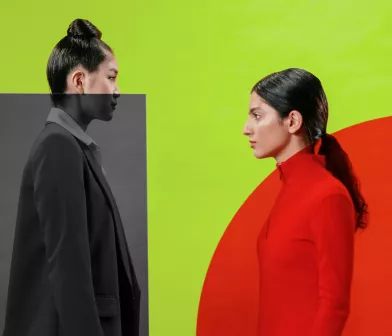
Mentality for target audience segmentation
How to choose your target audience and get to know them better
23.11.2022
Who are you developing a product or service for? Which type of individual aligns with the values of your brand? How do you choose your target audience and get to know them better? These are questions that we can answer for you based on experience and using a few handy tools. Today, we highlight the Mentality model from the values and lifestyle research agency, Motivaction.
The Mentality-model: why?
Nowadays, the influence of social and especially demographic characteristics on human behavior has diminished. If you want to successfully segment the target audience for your brand, you need to think deeper than just listing characteristics such as someone's place of residence, age, or background. It is important to gain more insight into the motivations and values of the target audience. Ultimately, it's about better understanding their way of life.
Eight milieus based on attitudes
Based on an extensive database, Motivaction has developed its own data bank. Using the data of over 23,000 individuals, they have categorized them into eight Milieus. The model divides individuals into one of these eight lifestyle environments. Each milieu is defined based on personal beliefs and values associated with different lifestyles. Individuals belonging to the same milieu often exhibit similar ambitions and behaviors. They also share values and motivations with each other. In this blog post, we will delve into each milieu individually.
Curious about which Mentality milieu your target audience fits into? Take the test here and find out!

1. Tradionals
In the first milieu of the Mentality model, we find the Traditional bourgeoisie. They are individuals focused on the status quo, holding onto moral values, traditions, and material possessions. Their goal is to live according to traditional norms and values. They aspire to a quiet and harmonious life. They show engagement in society and politics and easily accept authority and rules. They have a need for order, routine, and discipline and tend to avoid risks. Generally, there are more women than men in this milieu. Young people and highly educated individuals are not commonly found here.
2. Modern mainstream
Part of the modern bourgeoisie are those who seek a balance between tradition and modern values. They are conformist and status-conscious. They aspire to status and gaining recognition. They see the family as the cornerstone of society. They desire acknowledgment and appreciation while also valuing authority and rules. In their work, they seek income, challenges, and security. Outside of work, they are focused on consumption and entertainment, finding pleasure in material possessions. In this milieu, we see an equal number of men and women. All age groups are represented evenly. Generally, individuals in this milieu have lower levels of education.

3. New conservatives
Reserved towards social and cultural change and welcoming of technological advancements are the new conservatives. This group of individuals seeks to protect social status while holding onto traditional norms and values. They are often interested in politics and history and tend to be critical thinkers. They view their accomplishments at work as part of their identity. Outside of work, they are interested in art and culture. They tend to avoid risks and generally live modestly. We often see more men than women in this group. Older individuals and highly educated individuals with higher incomes are more likely to be found in this milieu.

4. Post-materialists
Those who oppose social injustice and advocate for the environment are societal-critical idealists in search of self-realization: meet the post-materialists. They aspire to be supportive and socially conscious. Strive for self-development and socially and politically engaged. Reflective and critical of themselves and others. Generally, they are tolerant individuals who value solidarity. They are constantly seeking a healthy work-personal life balance and want to contribute to society. Similar to the new conservatives, their lifestyle is modest and individualistic. However, post-materialists are not focused on consumption and entertainment. Here, we often find more women than men. They are in general older, higher educated individuals.
5. Postmodern hedonists
Postmodern hedonists are pioneers of the experience culture. They aspire to be free and live in the present moment. They seek new experiences and value independence. They are generally less engaged in society and politics but support equal opportunities and maintain a tolerant attitude towards others. They live impulsively and adventurous lives. They enjoy casual matters, art, and popular culture. They prioritize friends over family but are also staunch individualists. Men and women are equally represented within this group. We see relatively more young people and highly educated individuals here.
6. Convenience-oriented
Individuals in this milieu are impulsive and strive for an carefree, enjoyable, and comfortable life. They desire material wealth and entertainment. They seek recognition and appreciation but have little ambition and show disinterest in society and politics. They value outward appearances and are focused on consumption. Generally, there are more men than women in this milieu. Older individuals are relatively less present here. Individuals with lower education levels and lower incomes are more common.
7. Social climbers
Social climbing individuals are individualists who aspire to pursue a career while seeking to break free from tradition and obligations. They are also fascinated by new technology and seek risks and excitement. They often look beyond borders and are open to innovation and change. This group is focused on technology, values personal freedom, and exhibits impulsive behavior. They are sensitive to status and value traditional role divisions within the family or other relationships. We often see more men than women in this group, as well as a relatively large number of young people.
8. Cosmopolitans
The cosmopolitan, in a nutshell, is a critical global citizen in search of personal development and experiences, integrated with modern values such as materialism, pleasure, and success. The average cosmopolitan is internationally oriented and takes an interest in society and politics. They are ambitious and strive for improvements in income, identity, and status. They can appreciate art and culture and are consumption-oriented. They are social and network but tend to connect with like-minded individuals. In this milieu, we see an equal representation of men and women. Younger individuals and those with higher incomes are more frequently found in this milieu.
Curious about our strategic approach?
Then, please contact us.




